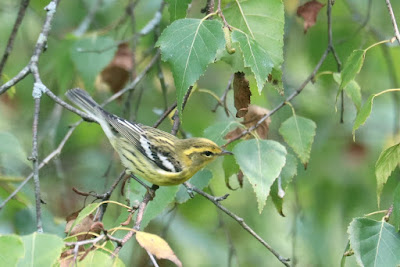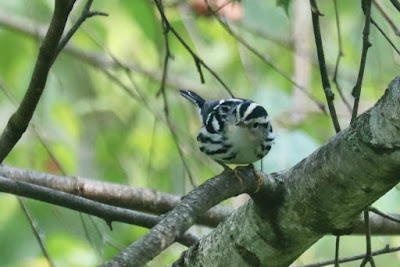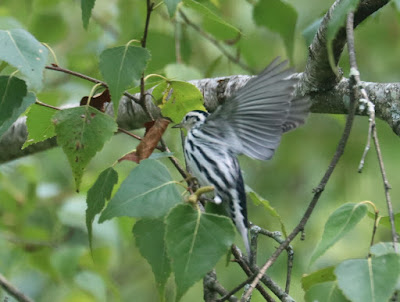The morning started beautifully, at 8:17 AM with this spring's rose-breasted grosbeak, trying to sing. He'd gotten strawberry jam all down his front. Just kidding--he's coming into his first adult plumage, but it's gonna take a couple years. I love seeing them when they're just showing the first hints of their sex.
28 Minutes of September
Tuesday, September 15, 2020
I went inside reluctantly, but I was due to be on a public radio fundraiser for WOSU with my dear friend Ann Fisher, and I wasn't about to miss that! I am deeply honored to be asked to help with a fundraiser. Ann asks such wonderful, unexpected questions, and I adore her and hold her in highest regard. I feel like this narrow sort of nature savant, where she's a brilliant generalist who knows something about everything. I know I'm kind of a break from the news, and I like serving in that capacity.
Well, I'd no sooner hooked up the Zoom audio connection with the Columbus OH radio station than a little wave of fall migrants came sweeping into my yard. I'm inside sitting at my drawing table, all tethered by headphones plugged into my laptop, and all this is happening outside!
11:09 am: A young female Blackburnian warbler peers quizzically through the birch twigs.
There's warbler action everywhere. I see a little magnolia go flitting through, but I don't get my lens on another bird until 11:14 when a young bay-breasted warbler lands on the feeder post.
You can see the traces of bay on his flanks, which tells us it's a male. How beautiful!
Bay-breast is sometimes hard to tell from blackpoll in fall, but you can almost always see a bit of bay on the flanks. The bay-breast has lead-gray feet and legs, while a blackpoll has yellow-orange feet. And baybreasts have sweeter, plainer faces and cleaner striping on the back than do blackpolls, which always look a tetch mean to me. Blackpolls have a stern line through the eye, bay-breasts less so.
At 11:19, the bay-breast fluttered over to a birch, where it made a lovely sight.
At 11:27, a beautiful young Blackburnian warbler appeared. I got a bunch of blurry photos, but this one was at least acceptable. It's a classic Audubon pose, showing every field mark--the very wide white wingbars, the pale backpack straps, and the strong, long eyeline. This is probably a young female, as it has no hint of orange in its yellow face. It's a girls' club today!
At 11:28, an eastern wood-peewee caught a little moth. How do I know it's a peewee and not an eastern phoebe? It's showing strong cinnamon wingbars, which a hatch-year phoebe would display as well. I know by the steepness of its forehead, and the slenderness of its body. Weird, but true. An eastern phoebe would look more flat-headed, with a larger head proportionate to its body.
Keep in mind that as I'm taking all these photos, I'm trying to sound cogent and informed about whatever Ann asks about. Ha ha! By now, Ann knows to ignore the sound of my shutter clicking as we talk. Science Chimp's gotta do what she's gotta do.
And it only got better! Here comes a female black and white warbler, at 11:30! One of my very favorites!
Black and white warblers creep all over trunks and limbs, like a nuthatch does. They're looking for spiders, crickets, moths, larvae; anything that hides in bark crevices.
Here are the wings that will take her to a Costa Rican shade coffee plantation. And look, please, at the beautiful undertail and rump feathers, herringbone black and white. I always try to get a look at those perfect chevrons.
We know this is a female by the clear white throat. A male would have black striping there. See that long, long bill, for probing in the bark? Black and whites also have a very long and strong hallux, or hind toe, for hanging head-down! Just like a nuthatch.
Only two minutes later, at 10:32, along comes a Cape May warbler. You're going to have to trust me on this ID. There are so many things that factor in here, but one of them is that we get floods of Cape Mays in the fall, and I just know them. But how, you ask?
Well, there is no other fall warbler except perhaps a young female Pine, that has this precise shade of olive-drab. A young female Cape May and a young female Pine are the drabbest fall warblers there are.
The strong but blurry streaking on the chest and flanks is another good field mark for Setophaga tigrina, the Cape May, the little striped tiger.
And finally it displays for the camera its best field mark in any plumage--the lime green rump.
This photo was taken at 10:32, and the warbler wave was over.
Almost. A young bay-breasted warbler came right up to the studio window to say hello
and ask if I'd seen its most beautiful wings? Look at those long, tapered jobs--the wings of a long-distance migrant, who is headed to Central America. This bird is built to fly, and fly he will.
Even I am agog at all that happened in my Ohio yard in those 28 minutes, and I'm grateful to be able to share it with you just a couple of hours after it happened.
It is a comfort, as America lies sick and burning, battered by discord as it is by hurricanes and thick smoke, to know that beautiful birds are still hatching, fledging, and now on the move, headed for the tropics, still living out their small but important lives. The smoke from California and Oregon has finally made its way to Ohio, to steal September's blue, and turn the sun into a smudgy thumbprint. Ann Fisher invited me on the show to give her listeners a nature break, and I'm here to tell you that the fall warbler migration is in full swing, today, right now. Get out there and take it in! It'll save you.
If you'd like to listen, the show is archived at https://tinyurl.com/zickonWOSU
If you'd like to give to WOSU, a $20 monthly sustaining donation will get you a subscription to Bird Watcher's Digest AND a fleece neck gaiter, too!
Get out there and watch some warblers, will ya?
|
Widget for blogger by Way2Blogging | Via Spice Up Your Blog Gadgets
|





















12 comments:
I love your comment “small but important life”. Isn’t that the truth.
Thankyouthankyouthankyou as always, Julie. At the moment, I'm tied by the leg looking after a husband with Alzheimer's. But my heart is out there with all of you who know the fall warblers and can tell the rest of us about them.
Wow! Just Wow! and THANKS.
Loved this!!! Thank you for sharing!!!
Oh - this is SO delightful! I was listening to you with Ann this morning, as you kept remarking on the wonders passing along outside your windows, so it's particularly lovely to see the photos. Thank you for multitasking!!
Thank you for the insight and photos to share your knowledge with us, Julie. I always enjoy your interviews with Ann Fisher on All Sides. I am grateful that all this modern technology allows me (in Wisconsin) to listen to you (in Ohio) and share the seasonal migration.
Your pal in Oregon here to thank you for the bird break, and to apologize for the poisonous, noxious smoke. It’s eerily quiet (no singing or chirping or crickets singing!) and awful here in Portland, and seeing posts like this (plus Curtis being a wild man on Instagram) really helps to keep me sane. Much love from Pickle and me, from beleaguered Portland, OR.
What a hopeful post, also introduced me to several birds I have never seen. That black and white warbler is stunning.
Oh my, what a wonderful welcome back to reading this blog. I stepped away for a time in an effort to reduce screen time. What a mistake!
I just learned about a thousand new things! Now I can practice connecting markings to all the new sounds I'm hearing outside! Thank you so very much!
You did all this WHILE speaking intelligently on the radio??? Seriously, lady; you're amazing.
@Jen...Hillhouse?
Post a Comment